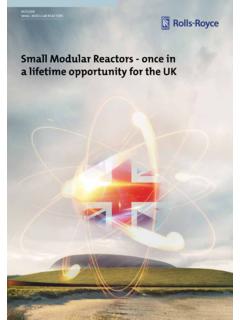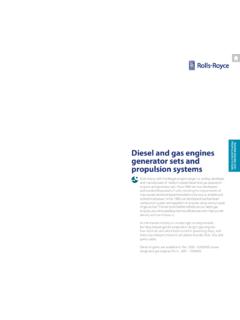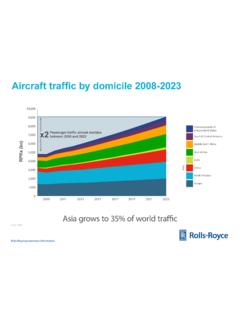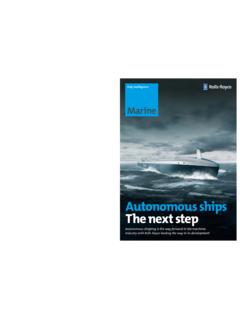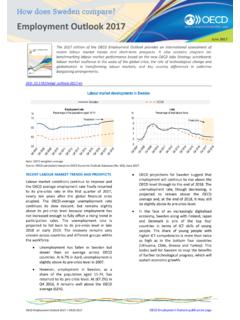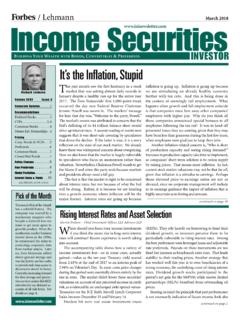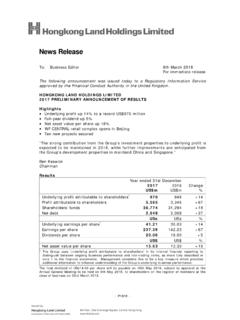Transcription of 7 March 2018 ROLLS-ROYCE HOLDINGS PLC 2017 …
1 1 7 March 2018 ROLLS-ROYCE HOLDINGS PLC 2017 FULL YEAR results ENCOURAGING results Commenting on the results , Warren East, Chief Executive, said: ROLLS-ROYCE made good progress in 2017 . financial results were ahead of our expectations and we achieved a number of important operational and technological milestones, but were impacted by the increasing cost and challenge of managing significant in-service engine issues. The business unit simplification and restructuring programme that we announced this January will drive further rationalisation and is a fundamental step in the journey started two years ago to bring ROLLS-ROYCE closer to its full potential both operationally and financially. We are encouraged by the improving financial performance in 2017 with growing revenues contributing to improved profitability and cash generation. Looking forward, sustaining this improvement and delivering increasing cash flow generation will strengthen our position as one of the world s leading industrial technology companies.
2 Underlying Reported Year to 31 December 2017 2016 Organic change* 2017 2016 Change Revenue ( m) 15,090 13,783 +6% 16,307 14,955 +9% Profit before tax ( m) 1,071 813 +25% 4,897 (4,636) N/M Earnings per share +27% ( )p N/M 2017 2016 Change Adj. Net debt ( m)** (520) (225) (295) Free cash flow ( m) 273 100 173 Payment per share * Organic change at constant translational currency ( constant currency ) and excluding M&A **Adj net debt excludes ITP Aero s 215m net cash. Reported net debt was 305m. FCF excludes 14m post-acquisition ITP Aero cash outflow Percentage or absolute change figures in this document are on an organic basis unless otherwise stated Group financial highlights Reported revenue of 16,307m; up 6% on underlying basis, Civil Aerospace service revenues up 12% Underlying profit before tax up 25% to 1,071m; strong contribution from Power Systems Reported profit before tax of 4,897m; includes a non-cash profit (2016: loss) from the revaluation of our $ hedge book as sterling strengthened Free cash flow improvement driven by improved profits and good working capital management 2016-17 transformation programme achieved 200m run-rate savings; at top end of guidance 718m ITP Aero acquisition completed in December 2017 , first instalment in shares ( issued) Group operational highlights Civil Aerospace widebody invoiced flying hours up 12%.
3 Significant in-service engine issues: in-year 170m cash cost (2016: 90m) and 227m charge to profit (2016: 98m) Large engine deliveries up by 35% to a record 483 (2016: 357 engines) Good further progress with Trent XWB-84 OE economics (cash deficit down 37%) Successful UltraFan Power Gearbox testing and Advance3 engine first run completed Strong recovery in Power Systems under new leadership; revenue growth, significant cost savings and strong cash generation Marine results stable year on year; restructuring benefits delivered; strategic review of Commercial Marine business underway 2 2018 Reporting & outlook ROLLS-ROYCE has adopted the IFRS 15 revenue recognition accounting standard from 1 January 2018 . As a consequence, our financial results for 2018 , commencing with the first half results , will be reported under IFRS 15. 2018 results will also be reported using the new business unit structure and therefore the outlook comments set out below are made on this basis.
4 The impact of adopting IFRS 15 is preliminary and as processes and procedures are further embedded during 2018 , it is possible that some changes to the impact may result. 2017 results : Previous business segment structure CURRENT ACCOUNTING IFRS 15 Underlying Revenue Organic change Underlying op. profit Organic change Underlying Revenue Underlying op. profit m % m % m m Civil Aerospace 8,023 +12% 520 +34% 6,613 (330) Defence Aerospace 2,275 -1% 374 -7% 2,282 370 Power Systems 2,923 +3% 330 +61% 2,919 331 Marine 1,077 -9% (25) +15% 1,075 (26) Nuclear 818 +4% 38 -18% 818 38 Other (26) (62) (25) (62) Total Group 15,090 +6% 1,175 +22% 13,682 321 2018 outlook : New business segment structure (IFRS 15 basis) m 2017 IFRS 15 2018 outlook Underlying revenue Civil Aerospace 6,613 High single-digit growth Defence 3,184 Stable Power Systems 3,106 High single-digit growth Other** 779 Group 13,682 Mid single-digit growth Underlying operating profit Civil Aerospace (330) Losses reduce by up to a third Defence 451 Margins around 250bps lower Power Systems 319 Margins stable Other** (119) Group operating profit 321 400m +/- 100m Free cash flow* 273 450m +/- 100m ITP Aero (excluded from above)** m Underlying revenue 827 Double-digit growth Underlying operating profit 75 Modest decline Free cash flow (7) FY18: (70)- (80)m.
5 Closer to breakeven in 2019 * Free cash flow outlook includes in-service engine costs as outlined on page 3 **Other includes Commercial Marine and HQ **ITP Aero will be reported as a separate unit. Note, the ITP Aero figures in the table are unaudited 3 Commenting on the Group s outlook , Warren East added: As I look to the year ahead, we are embarking on a more fundamental restructuring programme with a refreshed leadership team and an improved market environment. The new business structure provides us with a clearer focus on our customers and markets and, combined with our growing installed base, particularly of widebody engines, delivers the potential to drive sustainable long term free cash flow towards our mid-term ambition of around 1bn by around 2020 with further growth over the subsequent years. 2018 will be one of significant operational progress. In Civil Aerospace we will continue to grow our installed widebody fleet and further reduce cash deficits on engine sales.
6 At the same time over the next few years we will be continuing to implement solutions for our airline customers to address the in-service engine issues we are currently experiencing, the estimated costs of which are significant but are included in our cash flow, revenue and earnings guidance for 2018 and beyond. While Defence faces some challenges due to timing changes on export activity and in contract mix, we continue to have attractive longer term export opportunities. After a year of strong recovery, Power Systems is well positioned for another year of good progress, all of which bodes well for the year ahead. ROLLS-ROYCE business structure simplification and further restructuring In January 2018 we announced a programme to further simplify the business, including the evaluation of strategic options for Commercial Marine and a reduction from five business units to three tightly focussed operating businesses based around Civil Aerospace, Defence and Power Systems.
7 This rationalisation will facilitate a more fundamental restructuring, with empowered businesses supported by a much leaner corporate centre. The restructure will focus on operational restructuring of management, support and engineering and technology functions across the corporate centre and also in our three divisions, driving simplicity, agility and pace into our business. We are proposing to move to a considerably simplified staff structure, with fewer layers and greater spans of control across the group. We have retained restructuring experts Alvarez & Marsal to support us with this programme. We expect this programme to deliver a significant reduction in costs and assist us in improving performance across the Group as a whole, and we will provide clarity of these benefits later in the year. Civil in-service engine performance Our large engine fleet has continued to grow, with over 4,400 engines in active service at the end of 2017 , up 7%, on 2016. Invoiced flying hours increased by 12% compared with growth of 4% in 2016.
8 The Trent XWB-84 was a strong contributor to this growth. This engine now represents 6% of our in-service widebody fleet and has achieved over million flying hours with unparalleled levels of reliability. It is expected that the Trent XWB-84 fleet will grow to around 1,000 engines over the next five years. The Trent 700 (36% of our total widebody fleet) continued to perform well in service, and achieved a dispatch reliability of The RB211, Trent 500 and Trent 800 comprise 39% of the widebody fleet and are also performing well in service. We have, however, experienced an increased level of activity managing significant in-service engine issues on two engine programmes in 2017 . This has principally been due to lower than expected durability of a small number of parts for the Trent 1000 (11% of our total widebody fleet) and the Trent 900 (8% of our total widebody fleet). These issues have required urgent short-term support including both on-wing and shop visit intervention which has resulted in increased disruption for some of our customers.
9 This has been a dynamic situation. We have continued to progress our understanding of both the technical and operational issues and we are making solid progress with longer-term solutions, largely through re-designing affected parts. These are expected to be fully embodied in the Trent 1000 fleet by 2022. On the Trent 900, an extended life turbine blade is already being rolled-out into the current fleet with further re-designs underway which will be available in 2020. Total charges of 227m (2016: 98m) were recognised in the income statement in relation to the Trent 1000 and Trent 900 accelerated maintenance activity and 170m (2016: 90m) in our cash flow. Based on our current estimates, in 2018 the anticipated annual cash impact in respect of both the Trent 1000 and the Trent 900 is expected to broadly double from the total cash cost in 2017 of 170m and reach 4 a peak in 2018 , as maintenance activity intensifies. It is then expected to fall by around 100m in 2019.
10 The majority of the work will be undertaken in 2018 and 2019 although it is expected to be fully complete by 2022. All of these costs are included in our cash flow guidance for 2018 and beyond. Balance sheet, capital allocation and payments to shareholders A disciplined approach to capital allocation and to sustaining a healthy balance sheet will play a major part in driving our long-term growth. Through improved free cash flow generation we aim to maintain a strong investment grade rating and ultimately return to A-grade status. For 2017 the final payment to shareholders is held at pence giving a full year payment of pence (2016 full year: pence). Restoring our shareholder payments to an appropriate level over time as free cash flow grows will be a key capital allocation priority. Growing free cash flow will also help sustain our investment in R&D programmes. Through targeted investment we will capture carefully selected growth opportunities. We will provide more details for our capital allocation strategy at our Capital Markets event in June 2018 .


